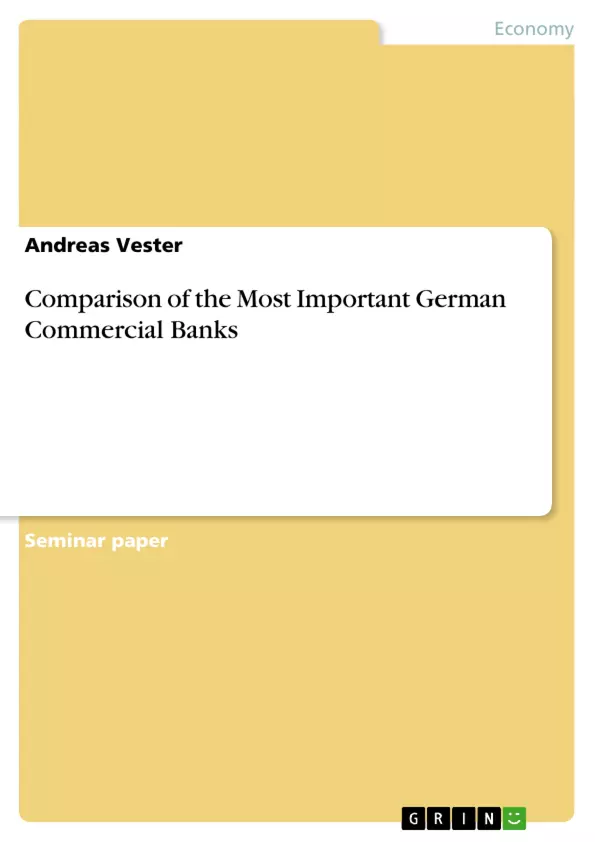The German banking industry is a highly regulated market with over 2,200 banks1. These banks are not equal at all. On the one hand, there are private owned commercial banks; on the other hand there exist savings banks, so-called ‘Sparkassen’, as well as ‘Genossenschaftsbanken’ that are equal to credit unions in the U.S. The German banking industry is just at the beginning of a structural change. In the recent past there have been a couple of mergers and bankruptcies within the banking industry. But a big change did not happen yet. In this paper we analyze the four biggest and most important German commercial banks -Deutsche Bank, HypoVereinsbank, Commerzbank, and Dresdner Bank - and their standing within the international banking industry. We examine the profit situation, the credit management, the worldwide role in asset management, as well as mergers and acquisitions during the past few years. Additionally, we expounded possible structural changes and chances within the German banking industry in the near future.
Inhaltsverzeichnis (Table of Contents)
- LIST OF TABLES
- LIST OF FIGURES
- ABSTRACT
- 1. INTRODUCTION
- 2. DEUTSCHE BANK AG
- 2.1. OVERVIEW
- 2.2. OPERATING BUSINESS EVALUATION
- 3. COMMERZBANK AG
- 3.1. OVERVIEW
- 3.2. OPERATING BUSINESS EVALUATION
- 4. ALLIANZ GROUP (DRESDNER BANK)
- 4.1. OVERVIEW
- 4.2. OPERATING BUSINESS EVALUATION
- 5. HYPOVE REINSBANK AG
- 5.1. OVERVIEW
- 5.2. OPERATING BUSINESS EVALUATION
- 6. COMPARISON BETWEEN GERMAN AND U.S. COMMERCIAL BANKS
- 7. ADVANCED ANALYSIS
- 7.1. ECONOMIC REASONS FOR THE RELATIVE UNDERPERFORMANCE OF GERMAN COMMERCIAL BANKS
- 7.2. MERGERS & ACQUISITIONS
- 7.3. GERMAN COMMERCIAL BANKS AND ASSET MANAGEMENT
- 8. SUMMARY & CONCLUSION
- REFERENCES
Zielsetzung und Themenschwerpunkte (Objectives and Key Themes)
This paper aims to provide a comprehensive analysis of the four largest and most significant German commercial banks, namely Deutsche Bank, HypoVereinsbank, Commerzbank, and Dresdner Bank. The paper examines their performance within the international banking industry, focusing on their profit situation, credit management, global role in asset management, and mergers and acquisitions in recent years. The paper also explores potential structural changes and opportunities within the German banking industry in the near future.
- The performance and standing of German commercial banks within the international banking industry.
- The profit situation, credit management, and asset management practices of the four major German banks.
- The impact of mergers and acquisitions on the German banking industry.
- The role of public guarantees and regulations in the German banking landscape.
- Potential structural changes and opportunities within the German banking industry in the future.
Zusammenfassung der Kapitel (Chapter Summaries)
Chapter 1 provides an overview of the German banking industry, highlighting its size, structure, and recent trends. It also introduces the four major commercial banks that will be analyzed in detail in subsequent chapters. Chapter 2 focuses on Deutsche Bank, examining its overview, operating business evaluation, and its position within the international banking industry. Chapter 3 delves into Commerzbank, providing an overview and evaluation of its business operations. Chapter 4 explores the Allianz Group, specifically Dresdner Bank, offering an overview and analysis of its performance. Chapter 5 covers HypoVereinsbank, providing an overview and assessment of its operating business. Chapter 6 compares the performance of German commercial banks with their US counterparts, examining key metrics such as return on equity (ROE) and return on assets (ROA). Chapter 7 conducts an advanced analysis of the German commercial banking industry, exploring economic factors influencing their relative underperformance, the role of mergers and acquisitions, and the importance of asset management.
Schlüsselwörter (Keywords)
This paper focuses on German commercial banks, specifically Deutsche Bank, Commerzbank, HypoVereinsbank, and Dresdner Bank. Key themes include their performance within the international banking industry, profit situation, credit management, asset management, mergers and acquisitions, structural changes, and opportunities within the German banking landscape. The paper examines the impact of public guarantees and regulations on the German banking industry.
- Citar trabajo
- Andreas Vester (Autor), 2004, Comparison of the Most Important German Commercial Banks, Múnich, GRIN Verlag, https://www.grin.com/document/49398



